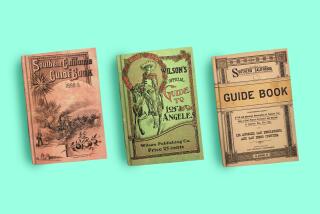AMERICAN PROGRESS:<i> by J. Valerie Fifer (Globe Pequot Press: $29.95) </i>
- Share via
This lively biography-cum-history reconstructs the life of George Andrew Crofutt, the hitherto anonymous author of the 19th Century’s most popular travel guides to the American West and coiner of the term “transcontinental.”
Crofutt’s life story allows the author to knit together a riveting account of the growth of the American transport and tourist industries. With a sharp eye for social geography, the author uses abundant detail and well-chosen photographs to show how the 19th-Century West provided the traveler with “a new idea of what it is to be an American citizen.”
Fifer’s story begins in Crofutt’s sleepy town of Danbury, Conn., where the industries were sleigh bells and silk hats, and in which travel was limited to stagecoach. (Danbury was not on the Erie Canal--but there is a map of the canal in the book because Crofutt later traveled it.) Crofutt moved to publishing ventures in Philadelphia, where he was editor of the newspaper, Monthly Rainbow, before setting off for the West. Each of the cities Crofutt visited--Philadelphia, Denver, Los Angeles--leads Fifer to a discussion of the most important means of transport of the period, together with the impact these had on tourism (and vice versa). The Los Angeles section includes a map of the Pacific Electric Railway system, which from the 1890s linked Pasadena, Los Angeles, Orange County and all the coastal ports from Long Beach to Santa Monica. We learn that the Grand Round was a “must” excursion for those wintering in Los Angeles; the full-day trip included visits to Lucky Baldwin’s Santa Anita Ranch, Sunny Slope Vineyards, Winery and Distillery and the San Gabriel Mission.
The 1860s marked what Fifer calls one of the most “concentrated advertising campaigns and regional promotions the world has ever seen,” and one which continues to serve as the model of tourist development schemes the world over. One of the effects of the tourist industry was “to make one part of our vast country known to the other,” a politically vital enterprise in the period of the Civil War and its aftermath. These guide books were good geography, not the “variegated vagabondizing” frowned upon by Mark Twain. Surprisingly, by the 1890s all the familiar features of the Western America’s tourist industry were already in place, including package tours, long-distance rail fare reductions, “everything under one roof” resort complexes and country clubs, health farms, dude ranches, and even pioneer reconstructions of “what-it-was-like-in-the-old-days” trips.
More to Read
Sign up for The Wild
We’ll help you find the best places to hike, bike and run, as well as the perfect silent spots for meditation and yoga.
You may occasionally receive promotional content from the Los Angeles Times.






